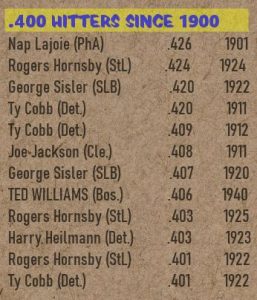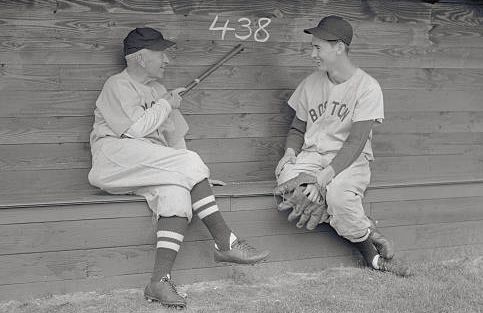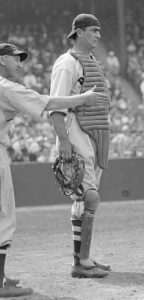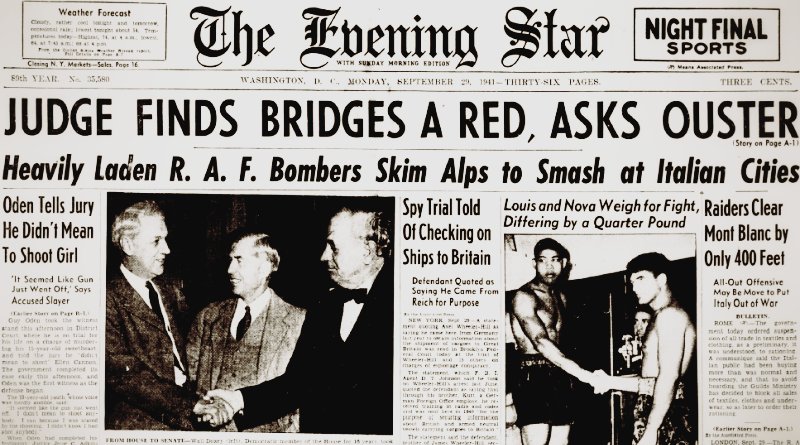World War II Chronicle: September 29, 1941
Click here for TODAY’S NEWSPAPER
.406

Ted Williams went 6-for-8 in yesterday’s doubleheader against the Philadelphia Athletics, belting a home run and a double (see page 16). The 23-year-old star is the first player to hit .400 for the season since Rogers Hornsby back in 1925.
Looking at the list, it’s impressive to note that Hornsby batted over .400 in three out of four straight seasons for the Cardinals. Detroit’s Ty Cobb did so in 1911 and 1912, and a third time ten years later.

Hugh Duffy, who set baseball’s all-time batting record in 1896, is mentioned having shared hitting wisdom with The Kid on page 15. 1894 sounds like ancient history to modern-day readers, and it is. When Hugh Duffy was playing for the Boston Beaneaters (1941’s Boston Braves, 2021’s Atlanta Braves), the uniform blouse still had collars and laced up. But for some perspective, 1894 was to 1941 America as 1974 is to us, and Reggie Jackson just recently stepped down as a special advisor to the Yankees. Duffy was a Red Sox institution for decades, serving as a scout and occasionally coached or served as a hitting instructor during Ted’s day. But back in 1894, Duffy set baseball’s all-time batting record at .440.
Duffy’s 1894 campaign was one of baseball’s best-ever, leading the league in base-hits (237), doubles (51), home runs (18), extra-base hits (85), total bases (374), and OPS* (1.196) home runs (18) and finishing in second for runs batted in (145).

Also on page 16, Washington Redskin’s Sammy Baugh looks pretty beat after a 17-10 loss to the New York Giants. Among those taking the field for New York was rookie end Jack Lummus who will join the Marine Corps and earn the Medal of Honor (posthumously) on Iwo Jima.
Moe Berg

Speaking of Red Sox coaches, former catcher Moe Berg coached first base for Boston in 1941. During Williams’ second season, he asked Berg what made hitters like Ruth and Gehrig great. Berg told him, “Gehrig would wait and wait and wait until he hit the pitch almost out of the catcher’s glove. As to Ruth he had no weaknesses, he had a good eye and laid off pitches out of the strike zone. Ted, you most resemble a hitter like Shoeless Joe Jackson. But you are better than all of them. When it comes to wrists you have the best.”
Berg will join the Office Of Strategic Services (OSS) during the war, and there are incredible stories of the 41-year-old former ballplayer parachuting behind enemy lines into Yugoslavia, infiltrating Nazi-occupied Finland to discover the location of a heavy water facility that the British then bombs, and even having orders to kill a German physicist if Berg can discover the Nazis are close to developing an atomic bomb.
While he was an OSS agent, and could speak several foreign languages, we don’t know if the stories about Berg are true. But we can’t say that they aren’t either; the intelligence business is pretty secretive, even decades after the fact.
We do know that Harry S. Truman awarded Berg the Medal of Freedom. His citation states “exceptionally meritorious service of high value to the war effort from April 1944 to January 1946.” The says he had a “position of responsibility” in the “European Theater.” Stories aside, Berg served his country. He may not have had a license to kill, but we know he served. And that is something to be very proud of.
* OPS: On-base percentage plus slugging percentage.
Evening star. (Washington, D.C.), 29 September 1941. Chronicling America: Historic American Newspapers. Lib. of Congress.
https://chroniclingamerica.loc.gov/lccn/sn83045462/1941-09-29/ed-1/
